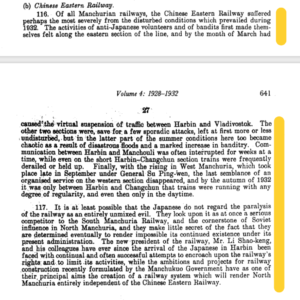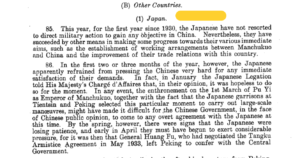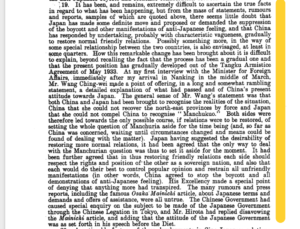It is interesting to look into the China Political Reports from the years of the Japanese establishment of Manchukuo, not only to provide an outsider’s perspective into Sino-Japanese relations, but also to analyse how the railway was used as a non-military method of control, and how railways were used by the British to interpret the often secret negotiations between China and Japan. The extracts analysed are taken from China Political reports from two volumes: Volume 4, containing reports written between 1928-32, and Volume 5 written between 1933-36. These were confidential documents, written by two British diplomats as part of the annual reports on China, for use of the foreign office. The first extract is from the 1932, the year Japan established Manchukuo, discussing the year’s impact on the Chinese Eastern Railway. It was telegrammed to Sir John Simon in Britain from Mr. Ingram, a British consul in China. The source describes how the Chinese Eastern Railway suffered the most during these years because of anti-Japanese sentiments, bandits along the eastern sections of the line, and floods, which resulted in the suspension of traffic between Harbin and Vladivostok, two major Russian railway towns. Meanwhile, the Southern Manchurian Railway (SMR) “borrowed and surpassed” Russia’s railway plans and insisted that the SMR’s facilities were the most modern available (Buck, 75). This leads to Mr. Ingram’s hypothesis that “it is at least possible that the Japanese do not regard the paralysis of the [Chinese Eastern Railway] as an entirely unmixed evil”- it is the main competitor of the SMR as well as the “cornerstone of Russian influence in North Manchuria”. The implications of this are that with the Chinese Eastern Railway weakened; the Japanese could continue exerting their influence in Manchukuo. If, as Buck frames it, Changchun represented the “inland extension of a foreign-dominated treaty port”, then the railways were the key to exerting control in a place without direct outright military action (Buck, 65). The Japanese gained control first through the railway, and then through the establishment of a government of Manchukuo.
The next set of extracts is from Sir Alexander Cadogan to Sir John Simon as part of the annual report on China in 1934, two years following the establishment of Manchukuo. 1934 also marked the first year since 1930 that “the Japanese have not resorted to direct military action to gain any objective in China” (p.278). Cadogan then goes on to speculate that because it would be a blow to Chinese public opinion to have any outright agreements with Japan, the two countries have been conducting their affairs “gradually and without any publicity” (p.270). Many of Cadogan’s interpretations are based on analysis of the railway traffic going between Manchukuo and China: it is in this way that China was able to negotiate a relationship with Japan without needing to publicly recognise the government of Manchukuo. The railway and the towns attached to them become important levers in establishing a peaceful relationship between the two countries.
A further report on the “subsequent developments in the general political situation between China and Japan” (p.331) were provided by Cadogan again on May 17, 1935. He states, with hints of personal annoyance, that it is “difficult to ascertain the true facts in regards to what has been happening” (p.336) between China and Japan, and that China was acting “with characteristic vagueness” (p.336) to meet Japanese demands and restore normal friendly relations. Cadogan’s annoyance here is probably indicative of the increased secrecy of negotiations between China and Japan, and an increased reliance on railways, infrastructure, and other elements of modernisation to protect Japan and China from Western aggression (245, Louise Young). Young argues that the railway exemplified just one method of building modernity within Japan and its empire, without needing any assistance from the West. Cadogan goes on to describe the “long and somewhat rambling statement” of the Minister of Foreign Affairs Wang Ching-wei, stating that both China and Japan have seemingly set aside the question of Manchukuo. Meanwhile, Japan was determined to increase the Japanese population in Manchuria while planning a highly ambitious development programme for their new territory, including the development of the railway, highways, air transport and communications networks (Tucker, 53). Japan would continue exerting control over Manchukuo through its commercial drive: by the end of 1936 there were countless Japanese shops, restaurants, hotels and other small businesses in railway towns throughout Manchuria (Young, 254). This is evidence that Japan was continuously asserting its dominance in Manchukuo, and that China was appeasing these demands, without the need for overt military force from either side. So, it is through no coincidence that these foreign reports on Sino-Japanese relations rely on railways and other commercial agreements to speculate on what diplomatic agreements were being reached by both countries- they often reveal more than official military or diplomatic discussions.
Bibliography:
‘Mr. Ingram to Sir John Simon: Annual Report, 1932’, in Robert L. Jarman (ed.), China Political Reports 1911-1960, Vol. 4 (Chippenham, 2001), pp.640-1.
‘Sir A. Cadogan to Sir John Simon: Annual Report 1934’, in Robert L. Jarman (ed.), China Political Reports 1911-1960, Vol. 5 (Chippenham, 2001), pp.269-336.
Buck, David D. “Railway City and National Capital: Two Faces of the Modern in Changchun” in Railway City and National Capital: Two Faces of the Modern in Changchun, pp.65-89.
Tucker, David “City Planning Without Cities: Order and Chaos in Utopian Manchukuo” in Mariko Asano Tamanoi ed., Crossed Histories: Manchuria in the Age of Empire, pp.53-81.
Young, Louise, Japan’s Total Empire: Manchuria and the Culture of Wartime Imperialism, Twentieth-Century Japan (Berkeley, Calif: University of California Press, 1999), “Brave New Empire: Utopian Vision and the Intelligentsia” pp.241-268.


